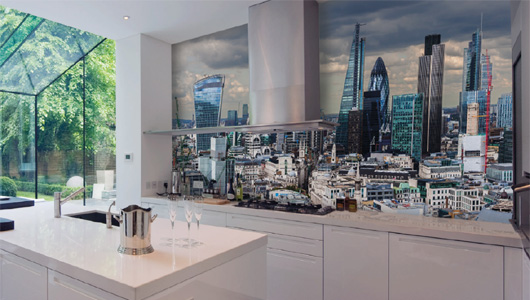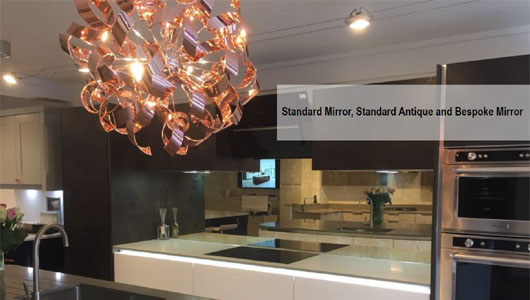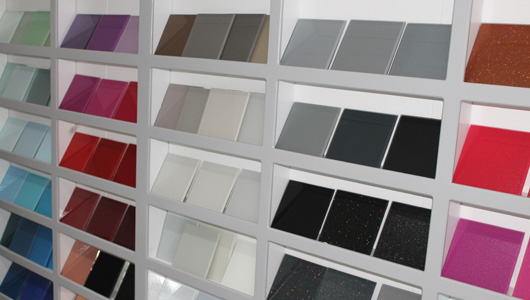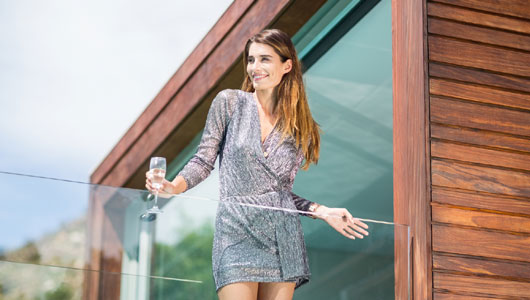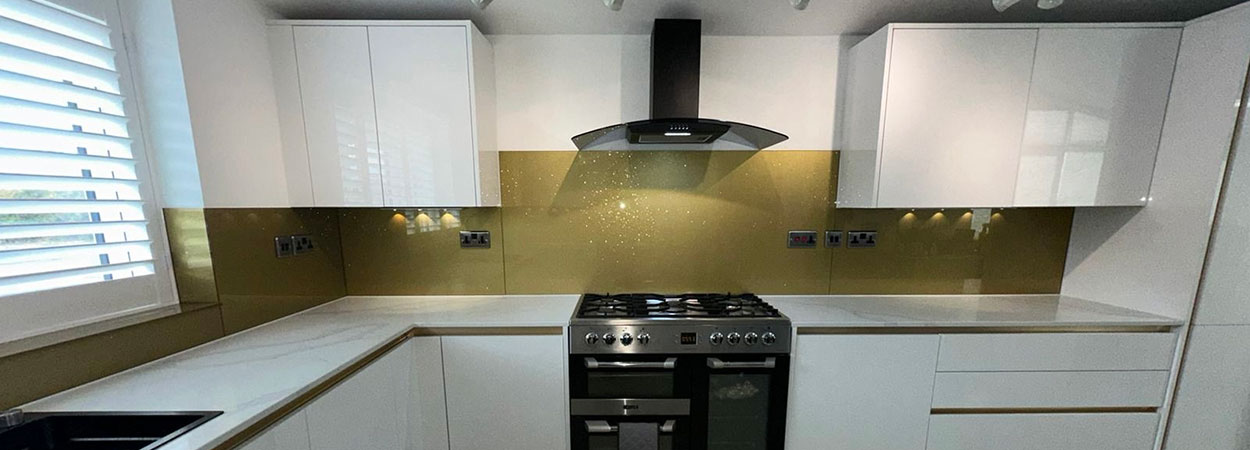
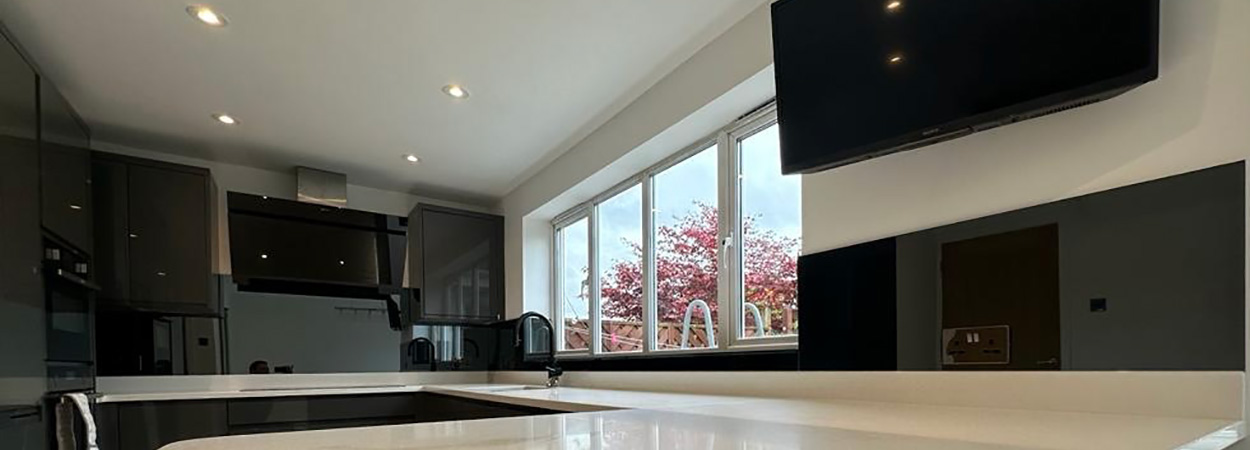
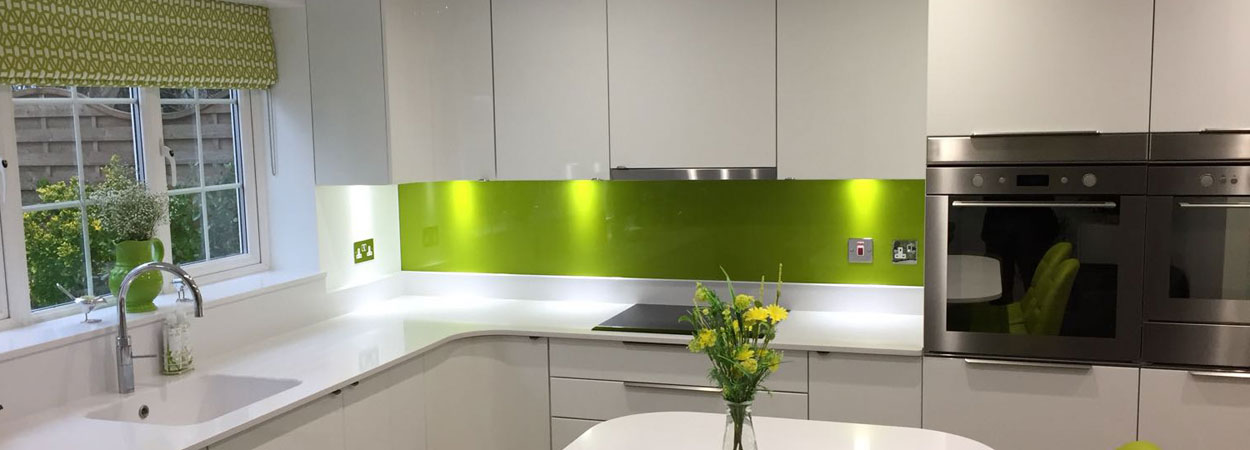
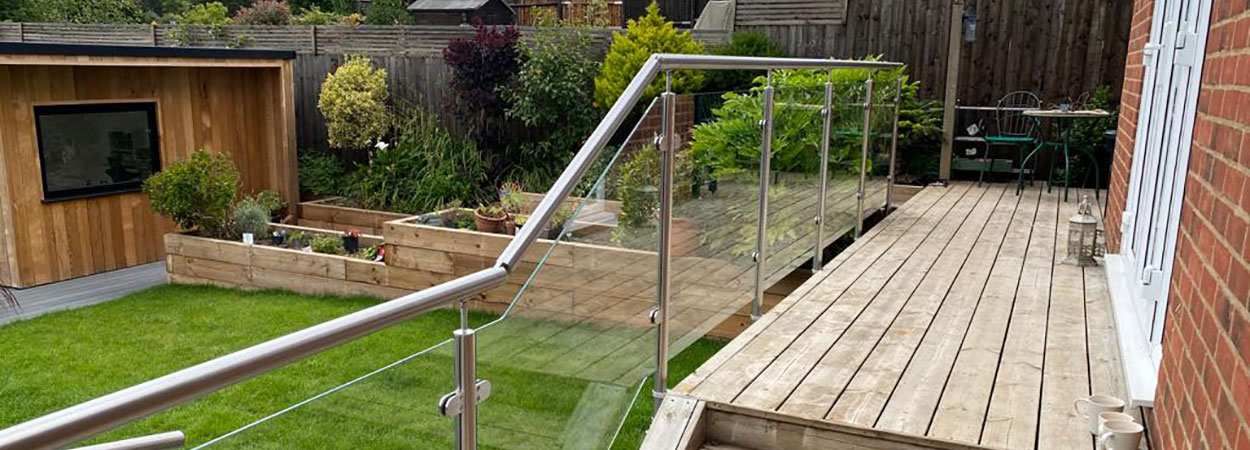
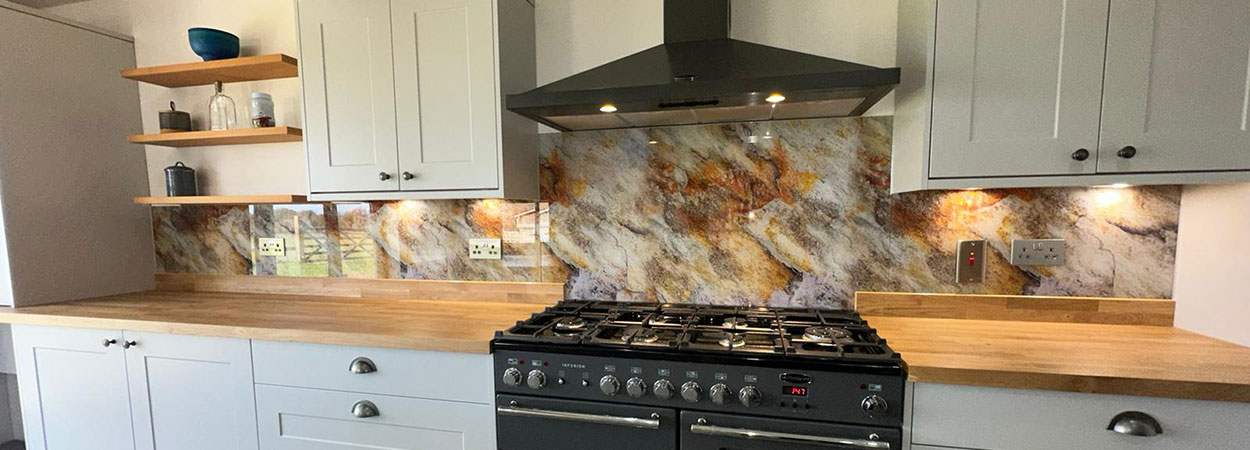
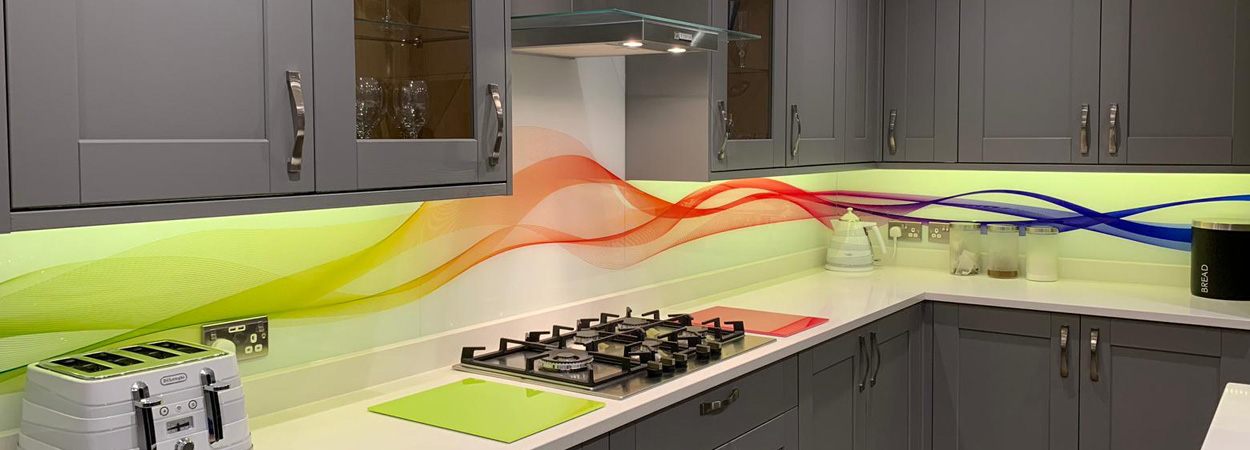


















Glass Splashbacks | Kitchen Splashbacks | Bathroom Splashbacks | Glass Balustrades | Canvey Island, Essex
Based in Stevenage, Hertfordshire, Splashbacks of Distinction have a real passion for toughened glass in and around the home. We have transformed many properties, both commercial and domestic with our glass splashbacks, for kitchens, bathrooms and living rooms. Our toughened glass balustrades, glass shelving and splashbacks with high resolution images have really caught the imagination of people who demand beauty and functionality in their homes and offices.
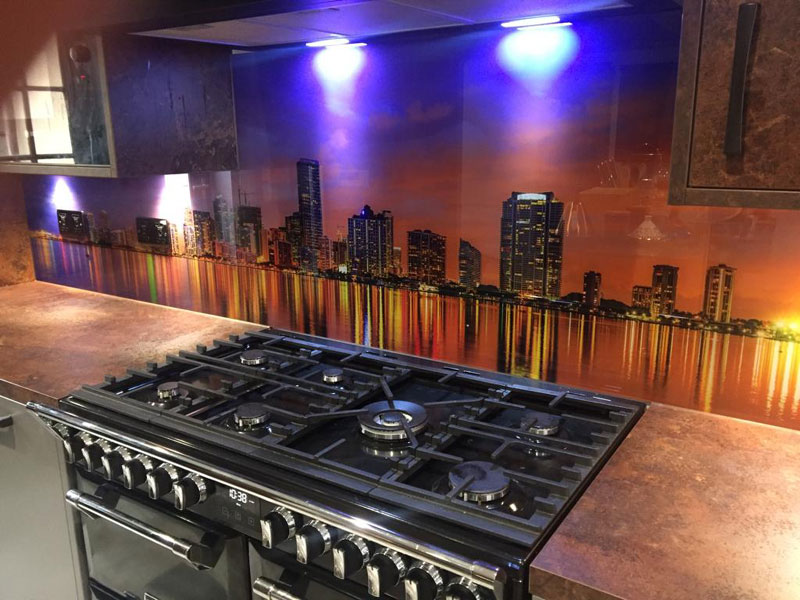
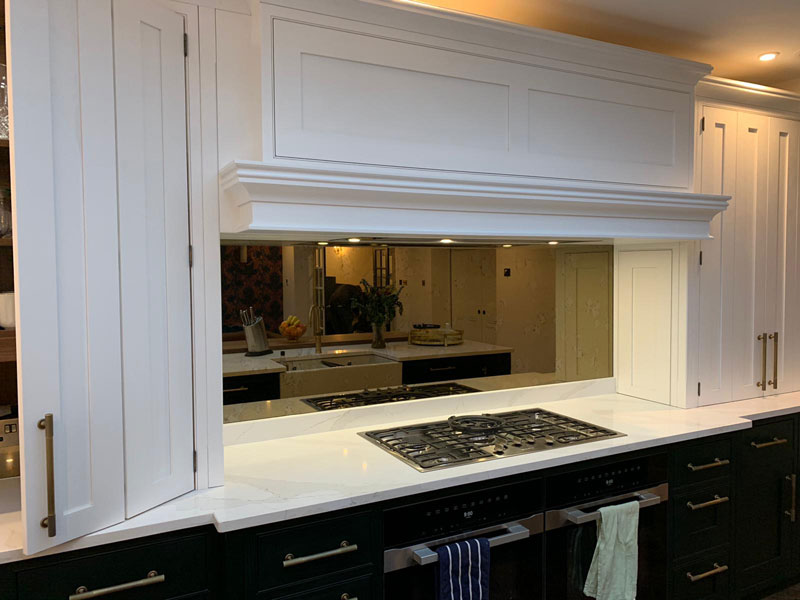
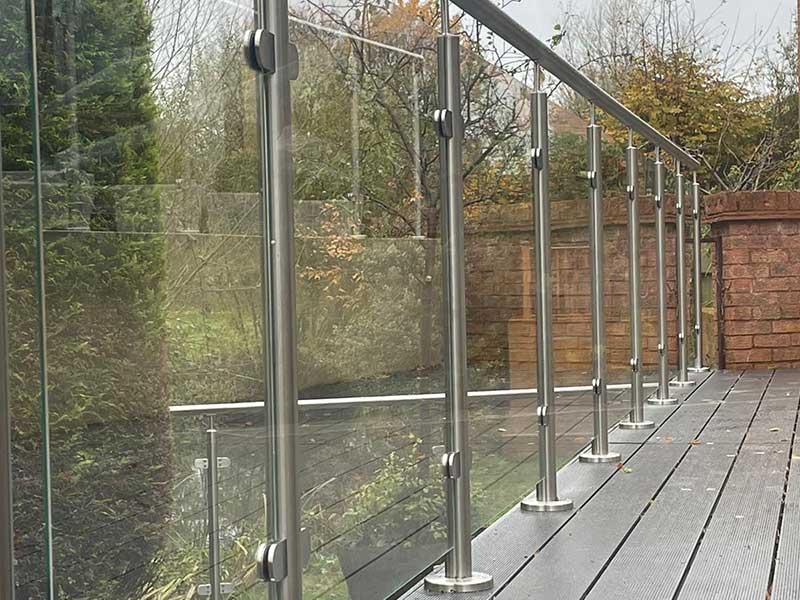
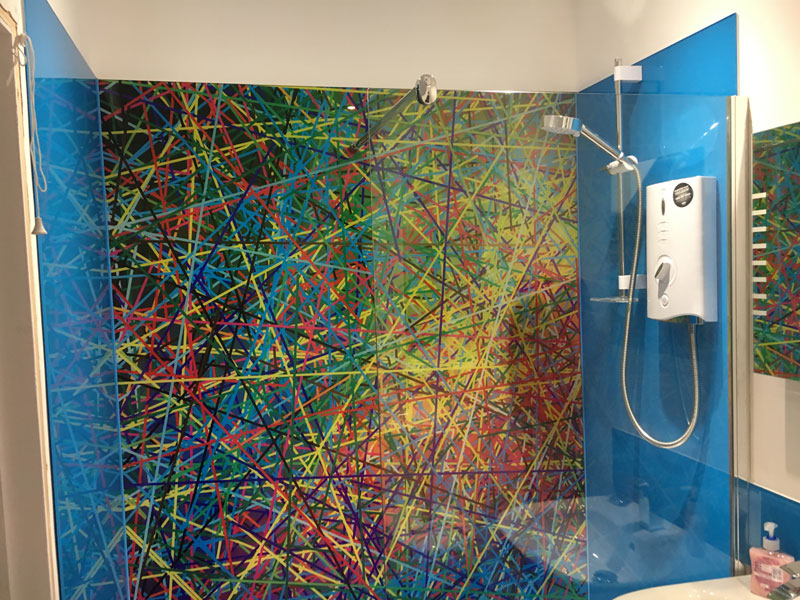
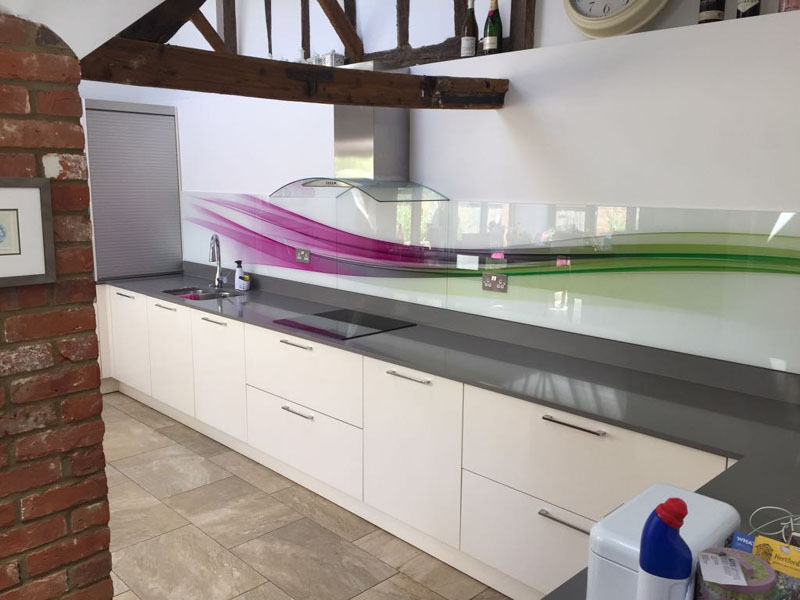
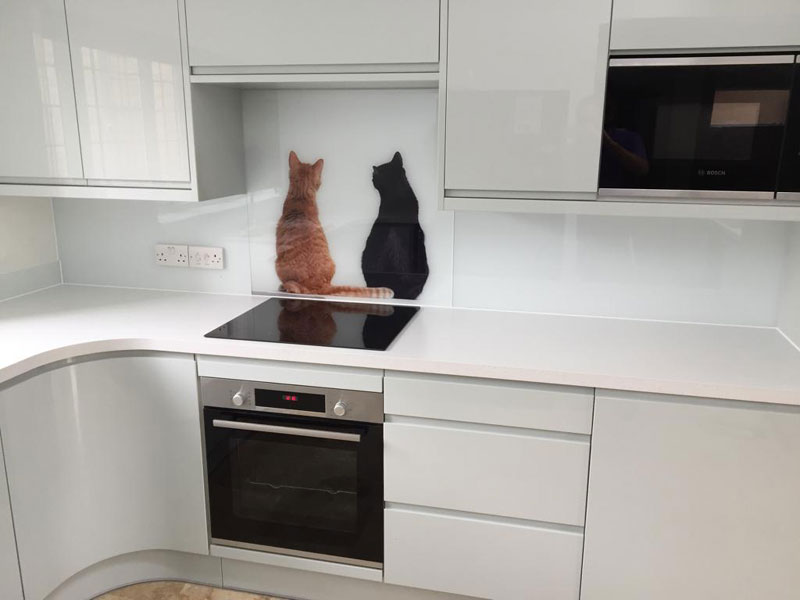
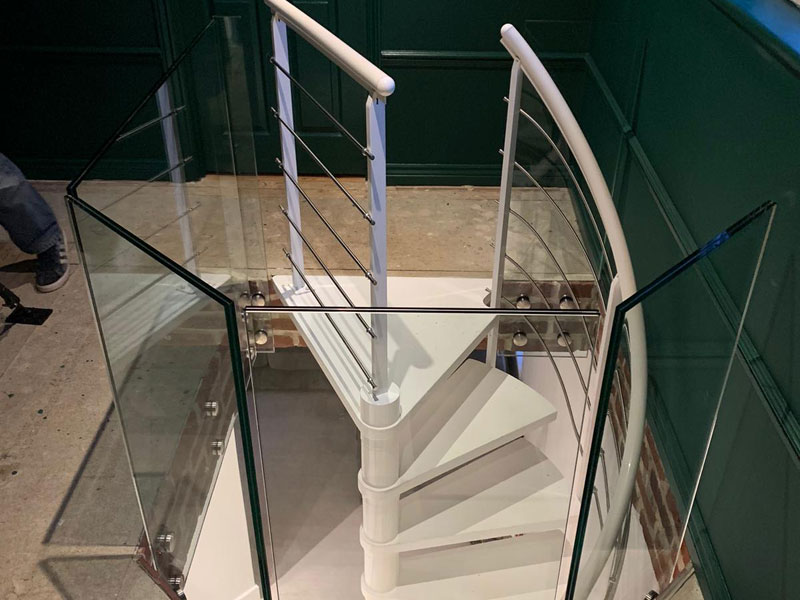
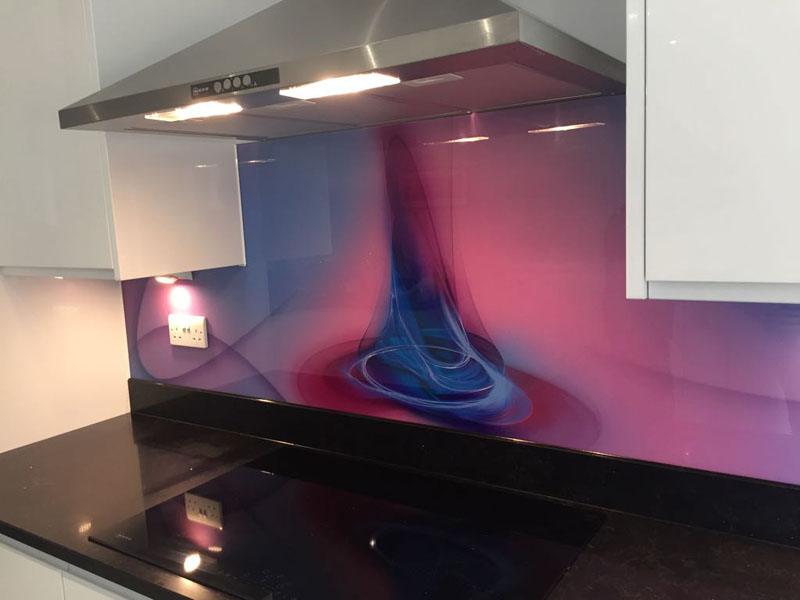
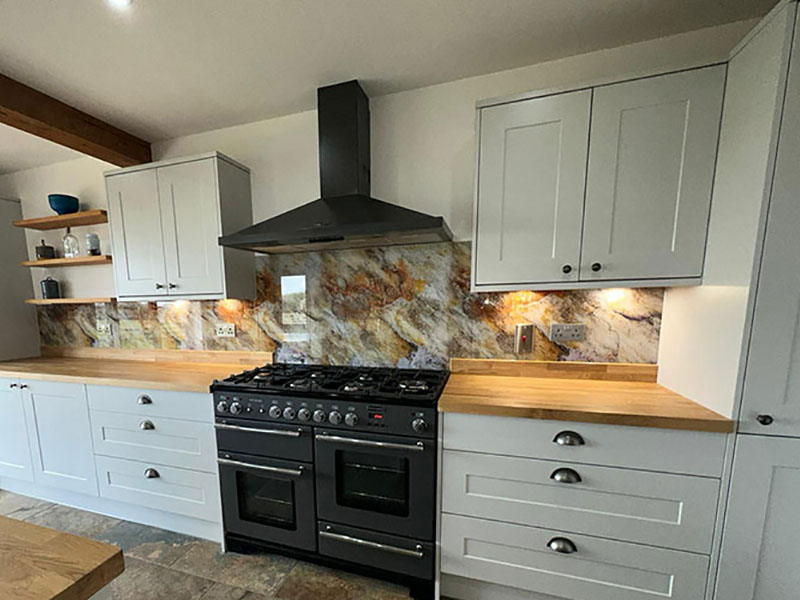
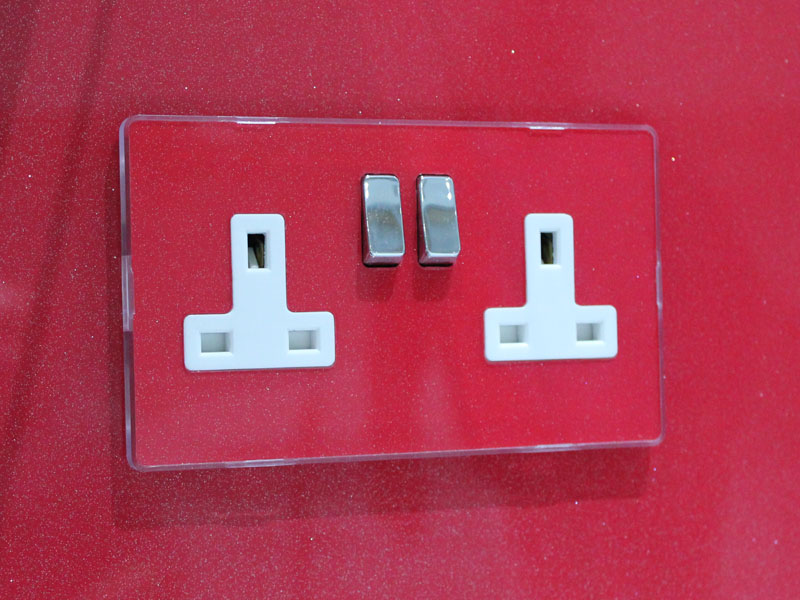


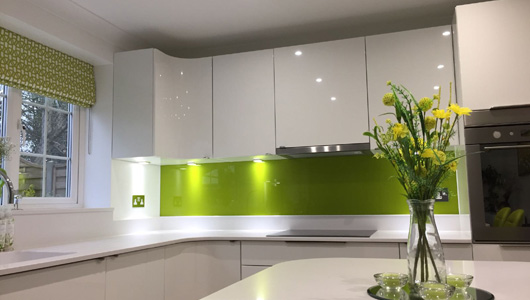
Splashbacks of Distinction
As one of the leaders in design and up to date technology, Splashbacks of Distinction are always on hand to deliver the highest standards of quality and service to our valued customers.
Splashbacks of Distinction provide a wonderful product that is suitable for kitchens, bathrooms, office spaces or anywhere you want a true touch of class.
Our splashbacks will add value and style to new and old kitchens and bathrooms. They are easy to clean and very hygienic. Every piece is toughened when manufactured so it is heat, water and impact proof.
A glass splashback and worktop will complement any bathroom, kitchen, bar area, laundry or shop. The sleek and seamless surface is the ultimate in elegance with zero visual interruption. Our glass splashbacks and worktops come in any colour and are also far easier to clean than ceramic tiles.
Should you require our services, please call or contact us by completing the simple contact form and we will get back to you as soon as possible.
Why not visit our show room or browse through our brochure
The Splashbacks of Distinction show room is located at Watton at Stone in Hertfordshire with easy access from Hertford, Stevenage and surrounding towns. It is close to both the A1 and A10 which makes it easily accessible from North London.
We have a wide range of samples, styles, colours and textures for you to see and touch. Our clients have told us that being able to visit our showroom really helps them to visualise and develop their ideas so that they really end up with exactly what they wanted. Our workshop is next to the showroom so you can also see our products as they are manufactured.
Hertfordshire Showroom Details
We have also created a stunning brochure with a selection from our range. This is available to download as a PDF by clicking on the link below.
Adding class to glass with our glass balustrades
Glass creates an illusion of more space and allows outside features to become part of the interior design. With glass it is possible to link two different spaces together without the barrier of a wall giving you the ability to enjoy your home and garden throughout the year.
Our frameless systems create a contemporary design which safely maximises any view, allowing natural light to spread across the living space. This solution can be used for internal stairs, external balconies, or to act as windbreaks in exposed areas outdoors.
Balustrade posts provide a classic, yet still very popular, design choice. Manufactured using 2.6mm thick walled, 48mm stainless steel for superior strength. This high quality, external grade steel maximises durability and minimises maintenance.
Glass spigots create a modern, minimalist design choice which maximises your view. Glass spigots are a large glass floor clamp that secures the glass vertically. The individual 'feet' allow for natural drainage making it an ideal choice for external areas including patio, and decked gardens, as well as poolside areas.
Massive range of printed splashbacks
The possibilities are almost endless. Whether you wish to modernise your home or office space, enhance it or create an eye-catching element in one of your rooms we are here to make your dream come true. Your wish is our command.
Perhaps a tropical landscape in the bathroom? How about a stylish banister or wall art? Or even a state-of-the art room divider?
If you own a business you might want to create a new inviting atmosphere for your customers or upgrade your existing space, making it uniquely stylish.
At Splashbacks of Distinction we can even recreate different surface patterns too. That wood-style surface you always wanted is now possible and it comes with all the advantages of glass. Our customers also love our granite and marble styles which are perfectly stunning.
NEW range of glass mirrors
When it comes to Mirrors, in either a Kitchen or Bathroom, nothing quite rivals the open, light and clean look that such a simple product offers.
Splashbacks of Distinction offer a range of standard mirrors available in Silver, Grey, Bronze and Peach with toughened options available.
Our bespoke antique mirrors offer depth and character, reflecting the beauty of its surroundings as well as enhancing them. Our collection of six unique mirrors can bring depth, glamour and a unique look to any space.
Choose from our range of antique mirror styles including moon, lava, mercury, Neptune, vincenzo, bronze vincenzo and bianco nero. Why not view our brochure or contact us today to see what we can do for you.
We can supply samples to help you choose
It is often very difficult to see what a particular colour or finish will look like from a picture. We understand that and can supply samples of your chosen splash back to enable you to get the best possible idea of what your dream kitchen or bathroom will look like before it is fitted.
We already have hundreds of samples available to look at in our showroom including different types of finishes such as glitter or sparkle. We can supply a sample in any colour or finish you would like from our extensive range.
Our splash backs are often so vibrant that it is very difficult to really appreciate them from a simple image and with some finishes, such as the mirrored finishes, it is virtually impossible. With a sample you can get a much clearer idea of how your splash back will look in your kitchen and how it will compliment the other colours and textures around it.
A complete service from measuring to final installation
At Splashbacks of Distinction we carefully manage the complete production, design and fitting of our bespoke, designer glass splashbacks.
Great care is taken to measure the intended space and our team will discuss your requirements and help with any ideas you have. Once we have finalised your design with our team, Splashbacks of Distinction can start to make the magic happen.
At every stage of the production process each of our panels is quality checked. Once one of our panels has left our workshop, we at Splashbacks of Distinction transport it and install it. Because each design is unique, it requires specialist knowledge to ensure correct fitting. Our team of experienced fitters will ensure that the panels are correctly aligned and mounted. We won't be happy until our customer is completely happy with the result.
Our team will work closely with you to create your dream design, ensuring the highest quality from start to finish so you can look forward to the magnificent result. We take pride in maintaining the highest of standards so that you, our customer can enjoy the beauty of our bespoke products.
The highest levels of safety and quality as standard
All of our glass splashbacks and panels are made using toughened glass. The glass is processed in accordance with the requirements of the relevant British and European quality standards BS EN 12150 : 2000 (Impact Tested BS EN 12600 : 2000).
You can rest assured that our glass splashbacks are safe and of the highest quality. Splashbacks of Distinction carries out rigorous checks to ensure that each panel is of the highest standard. At Splashbacks of Distinction we make sure that every panel is correctly aligned and fitted. Our toughened glass splashbacks are made to withstand daily use and will provide you with a strong, durable surface whilst maintaining their wonderful appeal and elegance. Reflecting natural light and brightening up dark corners, the splashbacks create an inviting, vibrant atmosphere.
Whether as a wall in a shower, as a room divider or a banister, our toughened glass will not let you down. It provides an excellent sealed barrier in kitchens and bathrooms where steam can cause havoc to walls and plaster.
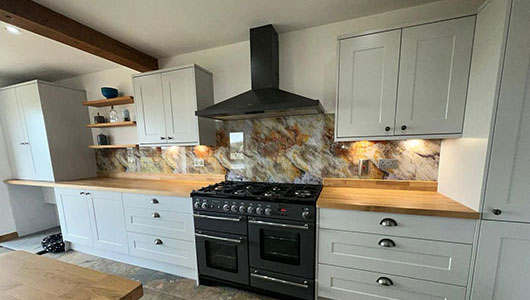
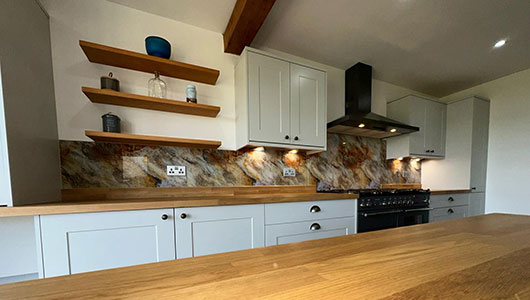
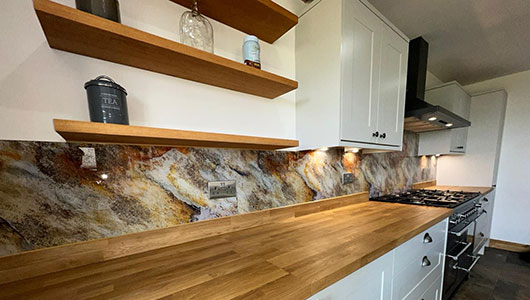
Wonderful customer service
I felt you really cared that we got the best effect for our kitchen and were happy to help us work through the options for as long as it took. Wonderful customer service and the splashback looks great.
(Kitchen splashback using design 010 from our own range)
Mrs Crawford, Aston”
Based in Stevenage, Hertfordshire, Splashbacks of Distinction have a real passion for toughened glass in and around the home. We have transformed many properties, both commercial and domestic with our glass splashbacks, for kitchens, bathrooms and living rooms. Our toughened glass balustrades, glass shelving and splashbacks with high resolution images have really caught the imagination of people who demand beauty and functionality in their homes and offices.
Canvey Island is a civil parish and reclaimed island in the Thames estuary. It is separated from the mainland of south Essex by a network of creeks. Lying only just above sea level it is prone to flooding at exceptional tides, but has nevertheless been inhabited since the Roman invasion of Britain.
The island was mainly agricultural land until the 20th century when it became the fastest growing seaside resort in Britain between 1911 and 1951. The North Sea flood of 1953 devastated the island costing the lives of 58 islanders, and led to the temporary evacuation of the 13,000 residents. Canvey is consequently protected by modern sea defences comprising 2 miles of concrete sea walls.
Canvey is also notable for its relationship to the petrochemical industry. The island was the site of the first delivery in the world of liquefied natural gas by container ship, and later became the subject of an influential assessment on the risks to a population living within the vicinity of petrochemical shipping and storage facilities.
Some Canvey Island history
Excavations on Canvey have unearthed a large collection of early man made objects such as axes from the Neolithic era, a bracelet dating from the Bronze Age, and Iron Age pottery. However, the remains of Roman structures and objects suggests the first settlement of Canvey occurred between AD 50 and 250. The remains point to a community existing with a farmstead, a garrison, a burial ground, and the operation of a large salt making industry was revealed by the existence of several red hills.
The discovery of a Roman road found to terminate 109 yards across the creek in neighbouring Benfleet suggests a means may have existed to facilitate the salts distribution to Chelmsford and Colchester, and the recovery of rich items of pottery and glassware of a variety only matched elsewhere by excavations of port facilities suggests the Romans may also have exploited the Canvey Island location in the Thames for shipping.
Canvey Island events
In 1607 the Elizabethan antiquarian William Camden noted in his work Britannia: a topographical and historical survey of all of Great Britain and Ireland, that Canvey Island was documented in the 2nd century by the Alexandrian geographer Ptolemy. In his work Geographia, Ptolemy mentions a headland in the mouth of the Thames to the east of the Trinovantes region called Counus Island. However, the difficulties faced in determining the location of land areas in Ptolemys ancient work have led modern researchers to question the correlation between Ptolemys island and contemporary Canvey Island. 18th century historians believe that Counus Island would have existed much further out to sea, or could have even been the Isle of Sheppey, so any similarity between the names is mere coincidence. Without any suitable island matching Ptolemys Counus Island, modern day historians think the documented island to have been lost or reduced to an insignificant sandbank by subsidence and the constant effects of the sea.
Saxon and medieval Canvey Island
The settlement and agricultural development of Essex by the Saxons from the 5th century saw the introduction of sheep farming, which would dominate the Canvey Islands industry until the 20th century. After the Norman conquest the area of Canvey Island was recorded in the Domesday Book as a sheep farming pasture under the control of nine parishes across south inland and coastal Essex; some of these parishes were on the adjacent mainland, but others were as far afield as Laindon and Prittlewell. Apart from the meat and wool produced from the sheep, the milk from the ewes was used for cheese-making. The abundance in later centuries would see the cheeses become a commodity taken for sale at the London markets, and at one stage exported via Calais to the continent.
The existence of several place names on modern Canvey Island using the wick suffix shows the influence of the early Saxon culture. The wick makes reference to the sheds in which the cheese was made.
It is believed that the name of Canvey Island is derived from the Anglo-Saxon Caningaege, meaning the Island of Canas People. Developments in the English language yielded the more familiar form Caneveye found in manorial records of 1254. The period of transition from Old to Early Middle English often give rise to confusions of orthography, leading, in this instance, to such variant spellings as Canefe, Kaneweye, Kaneveye and Koneveye. By the 12th century, Essex and subsequently Canvey Island were in the possession of Henry de Essex who inherited the land from his grandfather, Swein, son of Robert fitz Wymarch.
During the reign of Henry II, the land was confiscated from de Essex and redistributed among the Kings most favoured and loyal nobles.
14th century - 17th century Canvey Island
One of two octagonal Dutch cottages from the 17th century which are preserved on Canvey Island.
During Edward IIs reign the land was under the possession of John de Apeton and the first attempts were made at managing the effects of the sea with some basic defences, but periodical flooding continued to impact the population of mostly shepherds and their fat tailed variety of sheep for a further three hundred or so years. William Camden wrote of Canvey Island in 1607 that it was so low that it was often quite flooded, except the hills, upon which the sheep had a place of safe refuge. The uniform flatness of Canvey suggests that these hills are likely to be the red hills of the Roman saltmaking industry, or the early makeshift sea defences constructed by some of the early landowners around their farms.
In 1622, Sir Henry Appleton and Canvey Islands other landowners started a project to reclaim the land and wall the island to protect it from the River Thames. An agreement reached in 1623 stipulated that in return for inning and recovering the island, the landowners would grant a third of the land as payment for the work.
A broad drainage ditch was dug inland off the area facing the river while smaller inlets were filled in. Excess water would have collected in the broad ditch and then been discharged into the river by the means of seven sluices. The completion of the work saw a considerable number of the Dutch engineers take land as payment for their work, and consequently settle on Canvey Island. Approximately one third of Canvey Island streets have names of Dutch origin.
Splashbacks of Distinction are manufacturers and fitters of the highest quality toughened glass splashbacks and we are ready and waiting for your call. We are yet to fit a glass splashback in Canvey Island, but we're pretty sure it won't be long before someone there realises what a superb product it is and gives us a call. Nothing looks cleaner or more modern than a glass splashback, particularly when some tasteful under cupboard lighting is fitted to compliment the look.
Splashbacks of Distinction supply the following splashback products in Canvey Island, Essex
- Glass kitchen splashbacks
- Glass kitchen splashback samples
- Glass kitchen splashbacks in many different colours
- Printed glass splashbacks
- Colour matched splashbacks
- Painted splashbacks
Splashbacks of Distinction also supply the following glass products in Canvey Island, Essex
- Stainless steel and glass Balustrades
- Glass shelves
- Coloured mirrors
- Toughened mirrors
- Decorative glass
- Glass hardware
- Glass worktops
- Glass shower cubicle
- Garden glass balustrades
- Glass staircases
- Glass table tops
- Satin glass
- Toughened glass
- Laminated glass
- Opaque glass
Splashbacks of Distinction also supply the following glass related services in Canvey Island, Essex
- Glass cut to size
- Mirrors cut to size while you wait
- Glass processing
- Glass supply and installation
- Supply only splashbacks
- A glass express service
- Template and fit
Only the finest quality from Splashbacks of Distinction
Splashbacks of Distinction ensure that only the finest quality toughened glass is used in all our products. We guarantee all of our work and are fully insured. We employ only trained and certified engineers. Splashbacks of Distinction never leave your property without ensuring you are totally satisfied with your beautiful new glass splashback, baluster, shelving or shower enclosure.
Further Information
If you would like to know more or are interested in a quote we would be happy to help. Phone us on 01920 830 084, email us at enquiries@splashbacksofdistinction.co.uk or fill in our enquiry form and we will be in touch as soon as possible.
Areas covered in Essex:
- Basildon, Essex - Kitchen splashbacks | Bathroom splashbacks | Splashbacks with High Resolution Pictures | Glass Balustrades | Glass Shelves | Bespoke Mirrors | Bespoke Shower Screens and Enclosures | Acrylic Splashbacks | Glass splashbacks | Glass Worktops
- Billericay, Essex - Kitchen splashbacks | Bathroom splashbacks | Splashbacks with High Resolution Pictures | Glass Balustrades | Glass Shelves | Bespoke Mirrors | Bespoke Shower Screens and Enclosures | Acrylic Splashbacks | Glass splashbacks | Glass Worktops
- Braintree, Essex - Kitchen splashbacks | Bathroom splashbacks | Splashbacks with High Resolution Pictures | Glass Balustrades | Glass Shelves | Bespoke Mirrors | Bespoke Shower Screens and Enclosures | Acrylic Splashbacks | Glass splashbacks | Glass Worktops
- Brentwood, Essex - Kitchen splashbacks | Bathroom splashbacks | Splashbacks with High Resolution Pictures | Glass Balustrades | Glass Shelves | Bespoke Mirrors | Bespoke Shower Screens and Enclosures | Acrylic Splashbacks | Glass splashbacks | Glass Worktops
- Chafford Hundred, Essex - Kitchen splashbacks | Bathroom splashbacks | Splashbacks with High Resolution Pictures | Glass Balustrades | Glass Shelves | Bespoke Mirrors | Bespoke Shower Screens and Enclosures | Acrylic Splashbacks | Glass splashbacks | Glass Worktops
- Chelmsford, Essex - Kitchen splashbacks | Bathroom splashbacks | Splashbacks with High Resolution Pictures | Glass Balustrades | Glass Shelves | Bespoke Mirrors | Bespoke Shower Screens and Enclosures | Acrylic Splashbacks | Glass splashbacks | Glass Worktops
- Chigwell, Essex - Kitchen splashbacks | Bathroom splashbacks | Splashbacks with High Resolution Pictures | Glass Balustrades | Glass Shelves | Bespoke Mirrors | Bespoke Shower Screens and Enclosures | Acrylic Splashbacks | Glass splashbacks | Glass Worktops
- Chipping Ongar, Essex - Kitchen splashbacks | Bathroom splashbacks | Splashbacks with High Resolution Pictures | Glass Balustrades | Glass Shelves | Bespoke Mirrors | Bespoke Shower Screens and Enclosures | Acrylic Splashbacks | Glass splashbacks | Glass Worktops
- Colchester, Essex - Kitchen splashbacks | Bathroom splashbacks | Splashbacks with High Resolution Pictures | Glass Balustrades | Glass Shelves | Bespoke Mirrors | Bespoke Shower Screens and Enclosures | Acrylic Splashbacks | Glass splashbacks | Glass Worktops
- Epping, Essex - Kitchen splashbacks | Bathroom splashbacks | Splashbacks with High Resolution Pictures | Glass Balustrades | Glass Shelves | Bespoke Mirrors | Bespoke Shower Screens and Enclosures | Acrylic Splashbacks | Glass splashbacks | Glass Worktops
- Grays, Essex - Kitchen splashbacks | Bathroom splashbacks | Splashbacks with High Resolution Pictures | Glass Balustrades | Glass Shelves | Bespoke Mirrors | Bespoke Shower Screens and Enclosures | Acrylic Splashbacks | Glass splashbacks | Glass Worktops
- Great Dunmow, Essex - Kitchen splashbacks | Bathroom splashbacks | Splashbacks with High Resolution Pictures | Glass Balustrades | Glass Shelves | Bespoke Mirrors | Bespoke Shower Screens and Enclosures | Acrylic Splashbacks | Glass splashbacks | Glass Worktops
- Halstead, Essex - Kitchen splashbacks | Bathroom splashbacks | Splashbacks with High Resolution Pictures | Glass Balustrades | Glass Shelves | Bespoke Mirrors | Bespoke Shower Screens and Enclosures | Acrylic Splashbacks | Glass splashbacks | Glass Worktops
- Harlow, Essex - Kitchen splashbacks | Bathroom splashbacks | Splashbacks with High Resolution Pictures | Glass Balustrades | Glass Shelves | Bespoke Mirrors | Bespoke Shower Screens and Enclosures | Acrylic Splashbacks | Glass splashbacks | Glass Worktops
- Harwich, Essex - Kitchen splashbacks | Bathroom splashbacks | Splashbacks with High Resolution Pictures | Glass Balustrades | Glass Shelves | Bespoke Mirrors | Bespoke Shower Screens and Enclosures | Acrylic Splashbacks | Glass splashbacks | Glass Worktops
- Ingatestone, Essex - Kitchen splashbacks | Bathroom splashbacks | Splashbacks with High Resolution Pictures | Glass Balustrades | Glass Shelves | Bespoke Mirrors | Bespoke Shower Screens and Enclosures | Acrylic Splashbacks | Glass splashbacks | Glass Worktops
- Leigh On Sea, Essex - Kitchen splashbacks | Bathroom splashbacks | Splashbacks with High Resolution Pictures | Glass Balustrades | Glass Shelves | Bespoke Mirrors | Bespoke Shower Screens and Enclosures | Acrylic Splashbacks | Glass splashbacks | Glass Worktops
- Loughton, Essex - Kitchen splashbacks | Bathroom splashbacks | Splashbacks with High Resolution Pictures | Glass Balustrades | Glass Shelves | Bespoke Mirrors | Bespoke Shower Screens and Enclosures | Acrylic Splashbacks | Glass splashbacks | Glass Worktops
- Maldon, Essex - Kitchen splashbacks | Bathroom splashbacks | Splashbacks with High Resolution Pictures | Glass Balustrades | Glass Shelves | Bespoke Mirrors | Bespoke Shower Screens and Enclosures | Acrylic Splashbacks | Glass splashbacks | Glass Worktops
- Rayleigh, Essex - Kitchen splashbacks | Bathroom splashbacks | Splashbacks with High Resolution Pictures | Glass Balustrades | Glass Shelves | Bespoke Mirrors | Bespoke Shower Screens and Enclosures | Acrylic Splashbacks | Glass splashbacks | Glass Worktops
- Southend On Sea, Essex - Kitchen splashbacks | Bathroom splashbacks | Splashbacks with High Resolution Pictures | Glass Balustrades | Glass Shelves | Bespoke Mirrors | Bespoke Shower Screens and Enclosures | Acrylic Splashbacks | Glass splashbacks | Glass Worktops
- Saffron Waldon, Essex - Kitchen splashbacks | Bathroom splashbacks | Splashbacks with High Resolution Pictures | Glass Balustrades | Glass Shelves | Bespoke Mirrors | Bespoke Shower Screens and Enclosures | Acrylic Splashbacks | Glass splashbacks | Glass Worktops
- Stanford Le Hope, Essex - Kitchen splashbacks | Bathroom splashbacks | Splashbacks with High Resolution Pictures | Glass Balustrades | Glass Shelves | Bespoke Mirrors | Bespoke Shower Screens and Enclosures | Acrylic Splashbacks | Glass splashbacks | Glass Worktops
- Tilbury, Essex - Kitchen splashbacks | Bathroom splashbacks | Splashbacks with High Resolution Pictures | Glass Balustrades | Glass Shelves | Bespoke Mirrors | Bespoke Shower Screens and Enclosures | Acrylic Splashbacks | Glass splashbacks | Glass Worktops
- Waltham Abbey, Essex - Kitchen splashbacks | Bathroom splashbacks | Splashbacks with High Resolution Pictures | Glass Balustrades | Glass Shelves | Bespoke Mirrors | Bespoke Shower Screens and Enclosures | Acrylic Splashbacks | Glass splashbacks | Glass Worktops
- West Mersea, Essex - Kitchen splashbacks | Bathroom splashbacks | Splashbacks with High Resolution Pictures | Glass Balustrades | Glass Shelves | Bespoke Mirrors | Bespoke Shower Screens and Enclosures | Acrylic Splashbacks | Glass splashbacks | Glass Worktops
- West Thurrock, Essex - Kitchen splashbacks | Bathroom splashbacks | Splashbacks with High Resolution Pictures | Glass Balustrades | Glass Shelves | Bespoke Mirrors | Bespoke Shower Screens and Enclosures | Acrylic Splashbacks | Glass splashbacks | Glass Worktops
- Wickford, Essex - Kitchen splashbacks | Bathroom splashbacks | Splashbacks with High Resolution Pictures | Glass Balustrades | Glass Shelves | Bespoke Mirrors | Bespoke Shower Screens and Enclosures | Acrylic Splashbacks | Glass splashbacks | Glass Worktops

Showroom: Unit 11, Broomhall Farm, Watton At Stone, Hertford SG14 2RN
Splashbacks of Distinction is the trading name of RDC Glass Ltd









